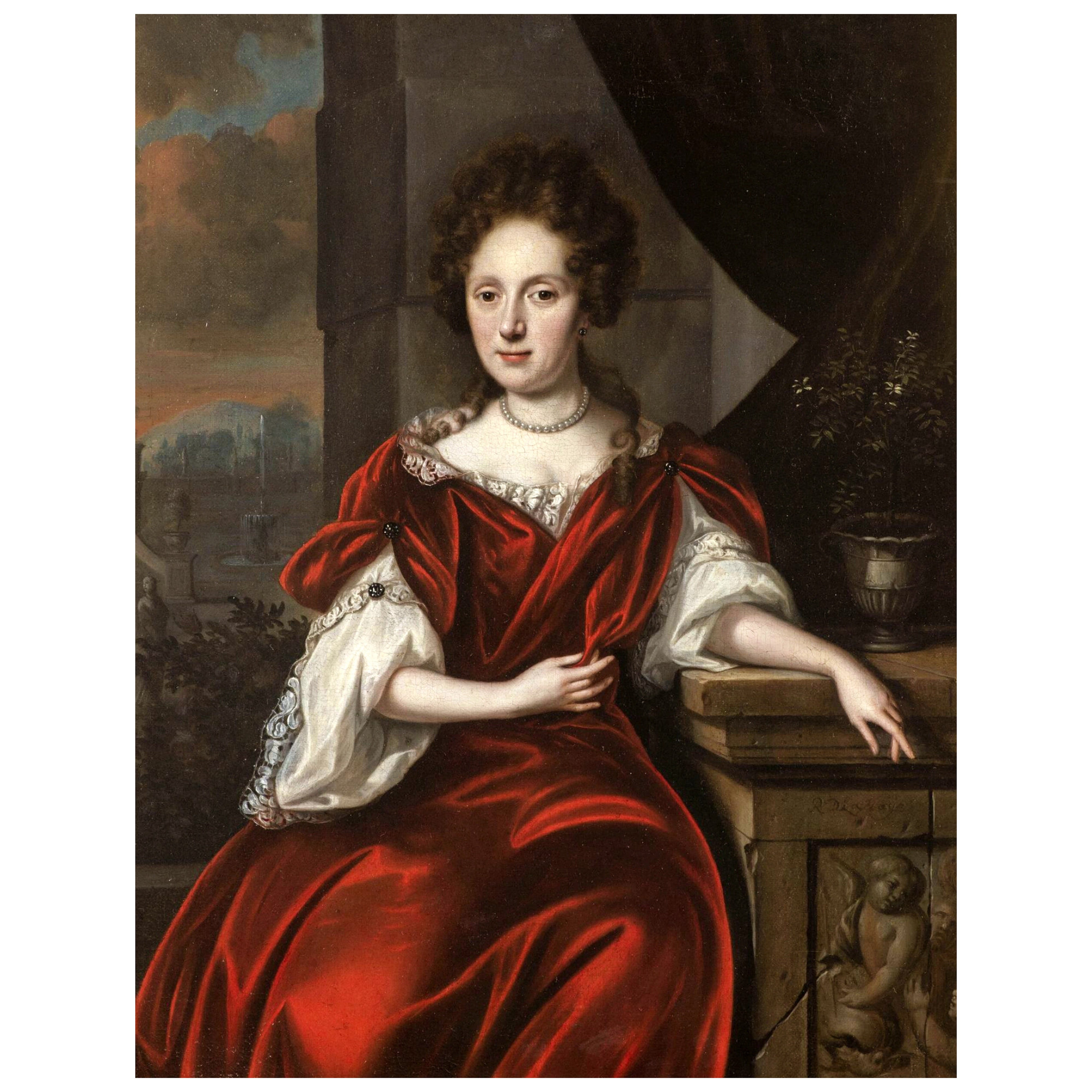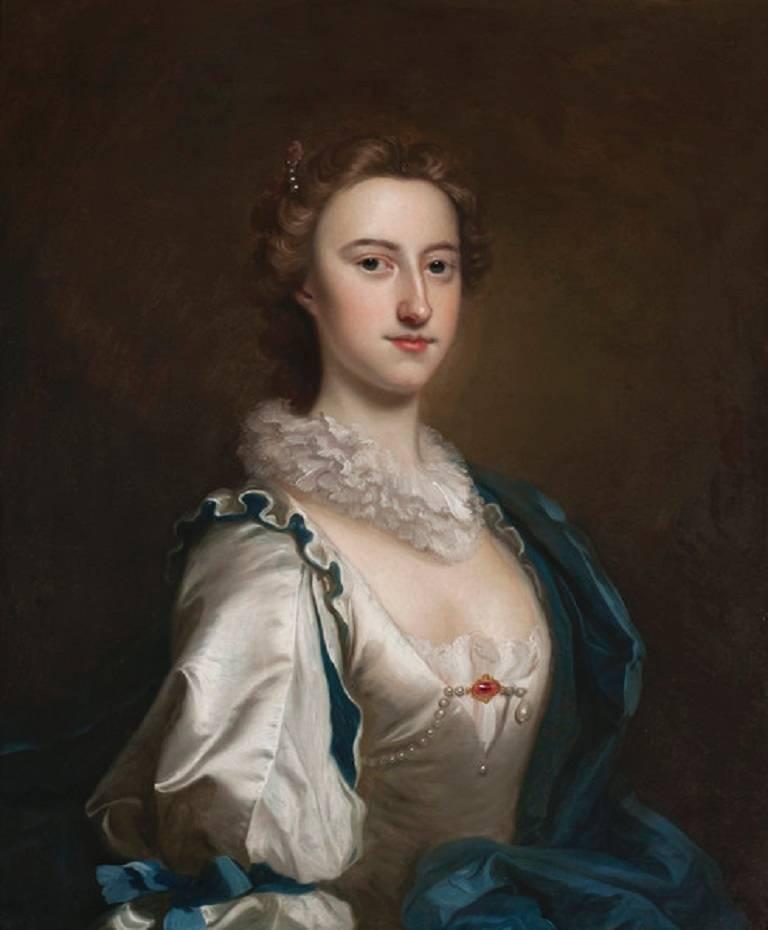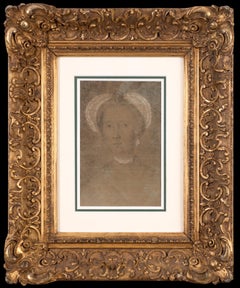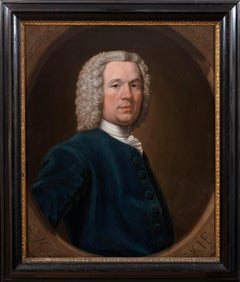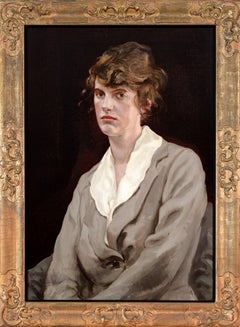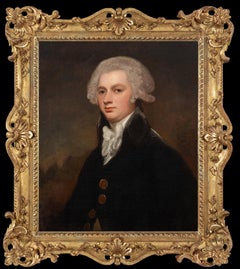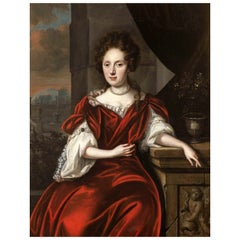Items Similar to Portrait of a lady in widow’s weeds, seated in an architectural setting
Want more images or videos?
Request additional images or videos from the seller
1 of 11
Portrait of a lady in widow’s weeds, seated in an architectural setting
$9,886.48
$13,044.6524% Off
£7,200
£9,50024% Off
€8,426.66
€11,118.5124% Off
CA$13,639.08
CA$17,996.0124% Off
A$14,993.11
A$19,782.5724% Off
CHF 7,879.69
CHF 10,396.8124% Off
MX$182,070.92
MX$240,232.4624% Off
NOK 98,297.14
NOK 129,697.6124% Off
SEK 93,129.63
SEK 122,879.3724% Off
DKK 62,890.28
DKK 82,980.2324% Off
About the Item
Charles d’Agar (1669-1723) (attrib.)
Portrait of a lady in widow’s weeds, three-quarter-length, seated in an architectural setting
Oil on canvas
In an original carved and gilded Lely frame
125.2 x 101.7 cm.; (within frame) 143.8 x 119.8 cm.
Provenance:
Private Collection, United Kingdom;
Christie’s, King Street, where consigned on 25 January 1979; Important English Pictures, 23 March 1979, lot 135, as Sir Godfrey Kneller;
Sotheby’s, London, Important British Paintings, 6 June 2007, lot 11;
Private Collection, United Kingdom.
Painted in three-quarter length, the elegant sitter wears a loose blue silk satin bodice over a white shift, which forms a gentle neckline and opens with gathered under-sleeves at her forearms. Her chestnut hair crowns into curls that fall underneath a long widow’s veil, which she holds to her cheek between clasped fingers. Sitting on a stone seat, she rests her elbow on a tabletop of dupont edge, decorated underneath with a carved acanthus motif that rises into a scrolled support. To her side is a broad pilaster supporting a cartouche encircled with a floral wreath, perhaps the funerary monument of the husband whom she mourns. Heavy silk drapery hangs down from behind and folds across the tabletop. The intimate and contemplative pose is one d’Agar used in numerous commissions, such as those of Lady Frances Carteret; Anne Lennox, Duchess Of Richmond And Lennox; and Lady Louise Lennox, Countess Of Berkeley. The work is of the standard dimensions used by d’Agar for three-quarter-lengths portraits.
The work was formerly identified as that of Sir Godfrey Kneller, and a later attribution to Michael Dahl was proposed by Sotheby’s in 2007. While Kneller and Dahl’s work was particularly close, stylistic features of the present work convincingly identify the artist as Charles d’Agar, a close follower of Dahl’s style, as inherited from Kneller himself. A French immigrant portraitist who had come to England with his father Jacques d’Agar, the d’Agars undertook a considerable number of aristocratic commissions.
The historical attribution to Godfrey Kneller was undoubtedly a more immediate answer to the lesser-known Charles d’Agar: as d’Agar never signed his works, mistaken attributions to Kneller are not uncommon. D’Agar’s style followed that of the master, though possessed a gestural manner that was identifiably his own. British portraiture had become dominated by the rapid studio practise introduced from the continent, and Kneller made full use of assistants to sustain a large output, establishing a dominating look known as the ‘Kneller mask’. Whereas other influences including Dahl preferred a gentler subtlety of tonal values and blending, d’Agar’s method is comparatively solid, using opaque and highly contrasted pigment layers shaped with broad defining brushstrokes. D’Agar’s loose working of the sitter’s bodice is characteristic, energetically scored wet-on-wet to create the highlights of the brilliant silk satin. The same is true of the sitter’s softly finished fingers, whose details are shaped with sparing touches. D’Agar’s approach is also typified by the mode of interior decoration. The stone seat and table edges are created with particularly thick pigment worked to a polished gradation. The sculpted table support is of a rising floral kind repeated by d’Agar throughout his works, most similarly in his portraits of Jemima Crewe, Duchess of Kent; Mary, Duchess of Chandos and John, Marquis of Carnarvon; and Barbara Ivory, Mrs Henry II Davenport.
Charles d’Agar was most likely born in Paris in 1669, the only son of the portrait painter Jacques d’Agar (1642-1715) and his wife Marie Picard. The protestant Agar family came to England around 1678-81, where Jacques d’Agar’s court commissions included a full-length portrait of Charles II’s French mistress, Louise de Kéroualle, Duchess of Portsmouth. The family travelled to Copenhagen in 1684 to allow Jacques to work at the courts of Christian V and Frederick IV, as a gentleman of the court and painter in ordinary to the king. Charles d’Agar was recorded in Copenhagen with his father between 1686-89, but had returned to London by 1691. Like his father, d’Agar enjoyed success as a court portraitist: by 1707 he was charging £12 for the same size of three-quarter-length portrait as the present work, and his works were often engraved as mezzotints for the London audience. D’Agar’s aristocratic patrons included the Churchill family, of whom he painted John Churchill, 1st Duke of Marlborough; Marlborough’s youngest daughter, Mary, Duchess of Montagu; and two of his granddaughters, Ladies Henrietta and Mary Godolphin. Indeed, the present portrait was owned by the same vendor as a portrait of Sarah Churchill, Duchess of Marlborough, attributed to Kneller; the two were offered together in the Christie’s sale of 1979 and Sotheby’s 2007 sale, selling for £31,200 in the latter. D’Agar committed suicide in London Fields in May 1723, making a widow of his wife Susannah. The antiquary George Vertue attended the sale of his prints and drawings, and remembered in his notebooks d’Agar’s popularity with women of the court, though too his violent affliction with gout and stone. Vertue noted that d’Agar left a son who was also a painter, possibly by the name of David.
Bibliography and further reading:
Waterhouse, Ellis Kirkham, Painting in Britiain, 1530 to 1790, 1 vols. (Yale: Yale University Press, 1994)
Waterhouse, Ellis Kirkham, The Dictionary of British 18th Century Painters in Oils and Crayons (Woodbridge: Antique Collector’s Club, 1981)
- Attributed to:Charles d'Agar (1669 - 1723, French, English)
- Dimensions:Height: 56.62 in (143.8 cm)Width: 47.17 in (119.8 cm)Depth: 3.94 in (10 cm)
- Medium:
- Movement & Style:
- Period:
- Condition:The work is in good and stable condition. Some light craquelure throughout, commensurate with age. Some losses of gesso and gilt to the outer frame edge. Slight markings to the outer paint edges. Minor discolouration to the lower varnish.
- Gallery Location:Maidenhead, GB
- Reference Number:1stDibs: LU2820215757922
About the Seller
No Reviews Yet
Vetted Professional Seller
Every seller passes strict standards for authenticity and reliability
Established in 2024
1stDibs seller since 2024
- ShippingRetrieving quote...Shipping from: Maidenhead, United Kingdom
- Return Policy
Authenticity Guarantee
In the unlikely event there’s an issue with an item’s authenticity, contact us within 1 year for a full refund. DetailsMoney-Back Guarantee
If your item is not as described, is damaged in transit, or does not arrive, contact us within 7 days for a full refund. Details24-Hour Cancellation
You have a 24-hour grace period in which to reconsider your purchase, with no questions asked.Vetted Professional Sellers
Our world-class sellers must adhere to strict standards for service and quality, maintaining the integrity of our listings.Price-Match Guarantee
If you find that a seller listed the same item for a lower price elsewhere, we’ll match it.Trusted Global Delivery
Our best-in-class carrier network provides specialized shipping options worldwide, including custom delivery.More From This Seller
View AllBust-length study of a fashionable lady, c. 1760s
Located in Maidenhead, GB
Robert Healy (1743-1771) (attrib.)
Bust-length study of a fashionable lady, c. 1760s
Black chalk on prepared laid blue paper, heightened with white
15.6 ...
Category
1760s Old Masters Portrait Drawings and Watercolors
Materials
Chalk
Portrait of George Gordon, 7th Laird of Buckie (1707-1756)
By John Alexander
Located in Maidenhead, GB
John Alexander (Scottish, 1686-1766)
Portrait of George Gordon, 7th Laird of Buckie (Scottish, 1707-1756), c. 1743
Oil on canvas
In a carved ebonised frame, with gilded inner slight...
Category
1740s Old Masters Portrait Paintings
Materials
Oil
Portrait of the artist’s cousin, Gladys Coombs (1899-1963), c. 1920-25
Located in Maidenhead, GB
John George Hookham (1899-1972)
Portrait of the artist’s cousin, Gladys Coombs (1899-1963), c. 1920-25
With a figure study verso
Oil on canvas
In an attractive, stylised ‘Lely’ type ...
Category
1920s Post-Impressionist Portrait Paintings
Materials
Oil
Portrait of a Gentleman, traditionally identified as Edward Addison, Esq., 1780s
By George Romney
Located in Maidenhead, GB
George Romney (1734-1802)
Portrait of a Gentleman, traditionally identified as Edward Addison, Esq., c.1780s
Oil on canvas
In a period carved and gilded swept frame
76.3 x 63.2 cm.; ...
Category
1780s Old Masters Portrait Paintings
Materials
Oil
Tête d’expression portrait study of a gentleman
Located in Maidenhead, GB
French Academic School, 18th century
A tête d’expression study of a gentleman, c. 1780-90
Oil on canvas
46.1 x 35 cm.; (within frame) 57.5 x 46.6. cm.
Provenance:
Private Collectio...
Category
1780s French School Portrait Paintings
Materials
Oil
The Virgin and Child with the Infant Baptist
By Andrea Del Sarto
Located in Maidenhead, GB
Florentine, mid-16th century
Circle of Tomaso D’Antonio Manzuoli, known as Maso da San Friano (1536-1571)
The Virgin and Child with the Infant Baptist
After Andrea del Sarto (1486-1...
Category
15th Century and Earlier Renaissance Figurative Paintings
Materials
Oil
You May Also Like
Reinier de la Haye (1640-1695) - PORTRAIT OF A LADY IN FRONT OF A PARK LANDSCAPE
By Reinier De La Haye
Located in Madrid, ES
Reinier de la Haye (1640-1695) - PORTRAIT OF A LADY IN FRONT OF A PARK LANDSCAPE Signed R. de la Haye on the right on the architectural base. Seated figure of a noble lady, dressed i...
Category
Antique 17th Century Dutch Baroque Paintings
Materials
Paint
Portrait of Lady in Silver Dress - Dutch Old Master art portrait oil painting
By Willem Wissing
Located in Hagley, England
This lovely Dutch Old Master portrait oil painting is attributed to circle of Willem Wissing. Wissing settled in England and emerged as Peter Lely's most important pupil after his de...
Category
17th Century Old Masters Portrait Paintings
Materials
Oil
Portrait of Mrs James Hoste - British 18th century art portrait oil painting
By John Vanderbank
Located in Hagley, England
This superb large three quarter length British Old Master portrait in a landscape oil painting is attributed to circle of John Vanderbank the Younger. Painted circa 1738 the sitter is Mrs James Hoste of South Wootton and Sandringham, nee Hammond. She was the daughter of Anthony Hamond and Susan Walpole, daughter of Robert Walpole, and was sister to Robert, 1st Earl of Oxford. She married Major James Hoste of Sandringham, Norfolk, and they had two daughters. The sheen of her blue satin dress against her gold cloak is stunning. A really lovely 18th century portrait with excellent provenance.
Inscribed with sitter details lower left.
Provenance. By descent within the family of the sitter at West Acre High House, Norfolk;
Cheffins, Cambridge, 'West Acre High House' sale, 24 November 2010, Lot 519; Wood Hall, Arkesden, Essex.
Literature: 'Portraits in Norfolk Houses', Prince Duleep Singh, 1927, No. 36.
Sitter's details on two labels verso.
Condition. Oil on canvas, image size is 50 inches by 40 inches and in good condition.
Frame. Housed in an ornate gilt frame, 58 inches by 48 inches framed and in good condition.
John Vanderbank (1694-1739) was an English portraitist and book illustrator, who enjoyed a high reputation for a short while during the reign of King George...
Category
18th Century Old Masters Portrait Paintings
Materials
Oil
$13,181 Sale Price
20% Off
Portrait of Mrs Harborough - British 18th century art portrait lady oil painting
Located in Hagley, England
This lovely 18th century Old Master portrait oil painting is attributed to the circle of noted portrait artist Enoch Seeman. Seeman came from Poland to England as a youngster with hi...
Category
18th Century Old Masters Portrait Paintings
Materials
Oil
Portrait of Lady with Garland of Flowers - British 17thC Old Master oil painting
By Michael Dahl
Located in Hagley, England
This charming 17th century Old Master portrait oil painting is attributed to the circle of Swedish born Michael Dahl who lived and work in England for most of his life. Painted circa...
Category
17th Century Old Masters Portrait Paintings
Materials
Oil
$8,787 Sale Price
20% Off
Portrait of a Lady, Old Masters 18th Century Oil
By Thomas Hudson
Located in London, GB
Thomas Hudson
1701 – 1779
Portrait of a Lady
Oil on canvas
Image size: 30 x 25 inches
Original carved giltwood frame
Hudson had many assistants, and employed the specialist drapery ...
Category
18th Century Old Masters Portrait Paintings
Materials
Canvas, Oil
More Ways To Browse
Antique Duchess
Henry Ii
A Dupont
George Vertue
Painting Of John Churchill Duke Of Marlborough
Charles Agar
Portrait Of A Knight
Portrait Painting Of Princess
Reuben Tam
Shotgun Shell Art
The Cheshire Cat
Thomas Lord
Abraham Lincoln Painting
Allan Ramsay
Anne Boleyn
Art Antique Pre 1900 Paintings
Black Velvet Paintings Of Churches
Bob Roberts Painting
